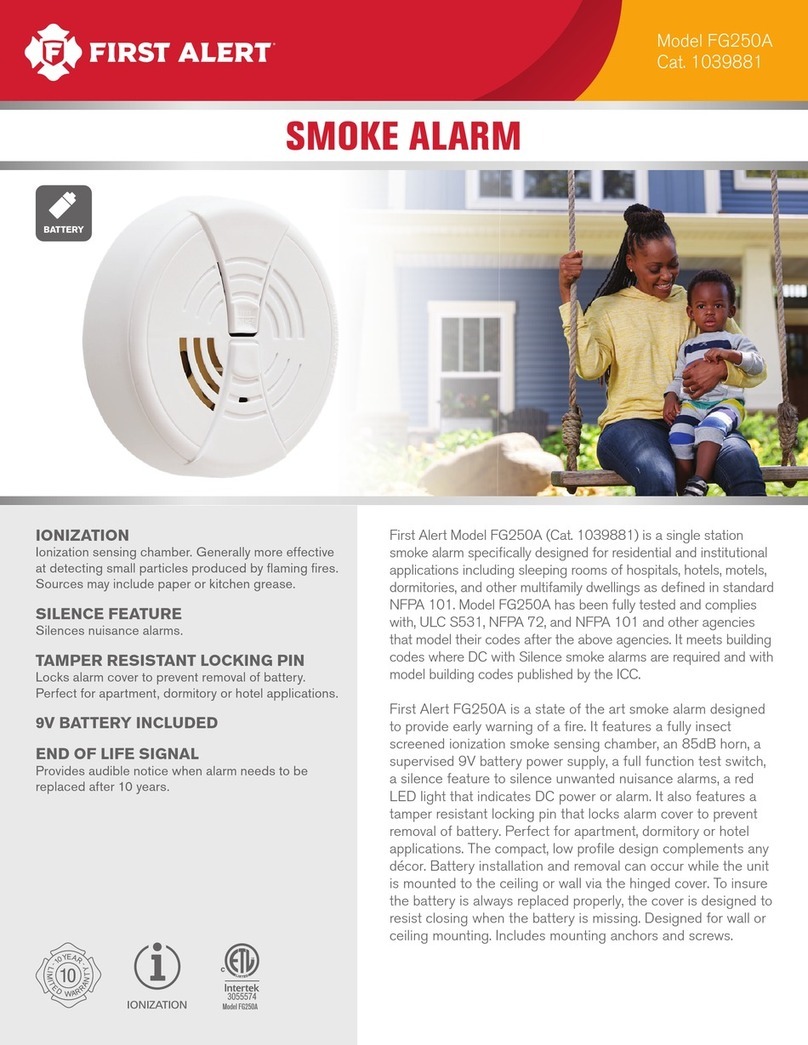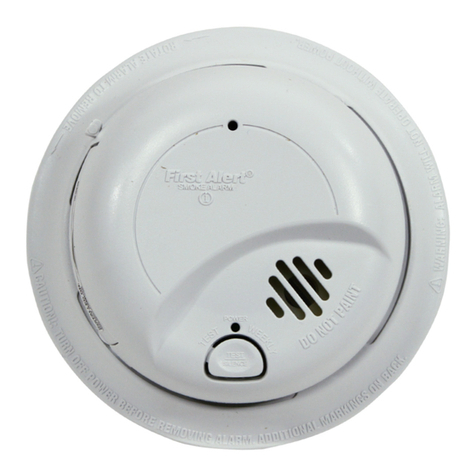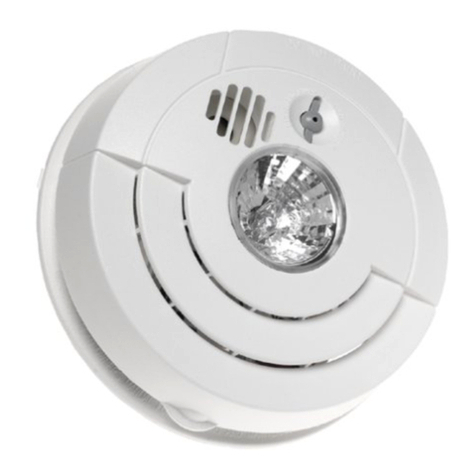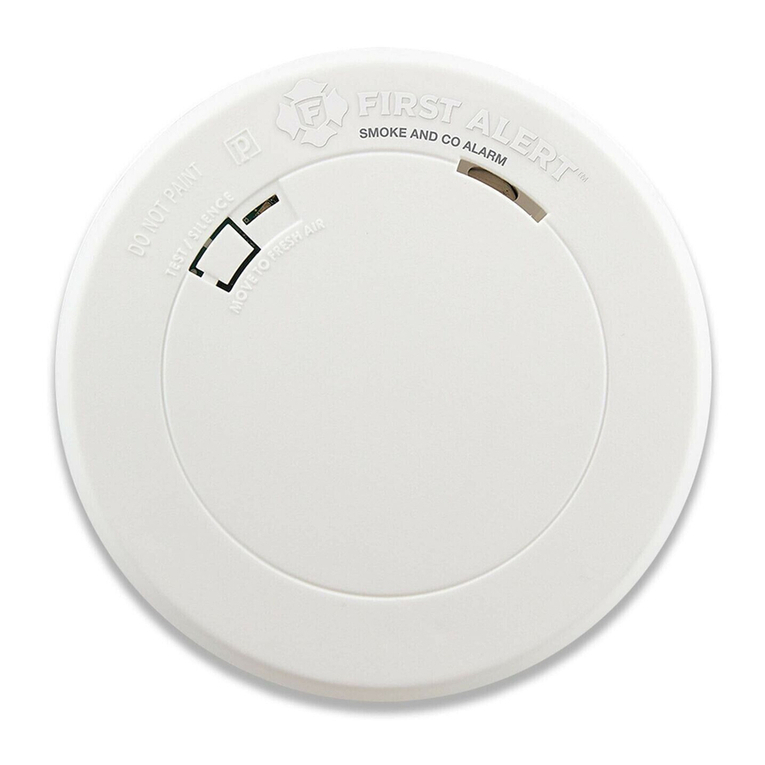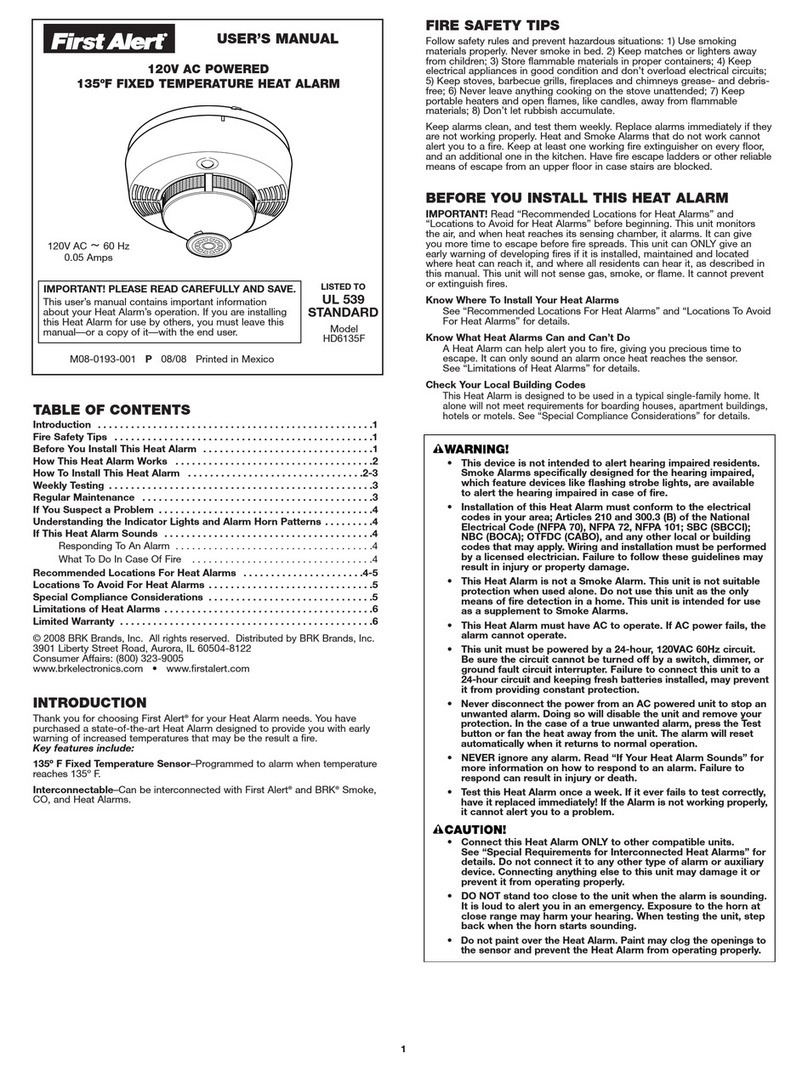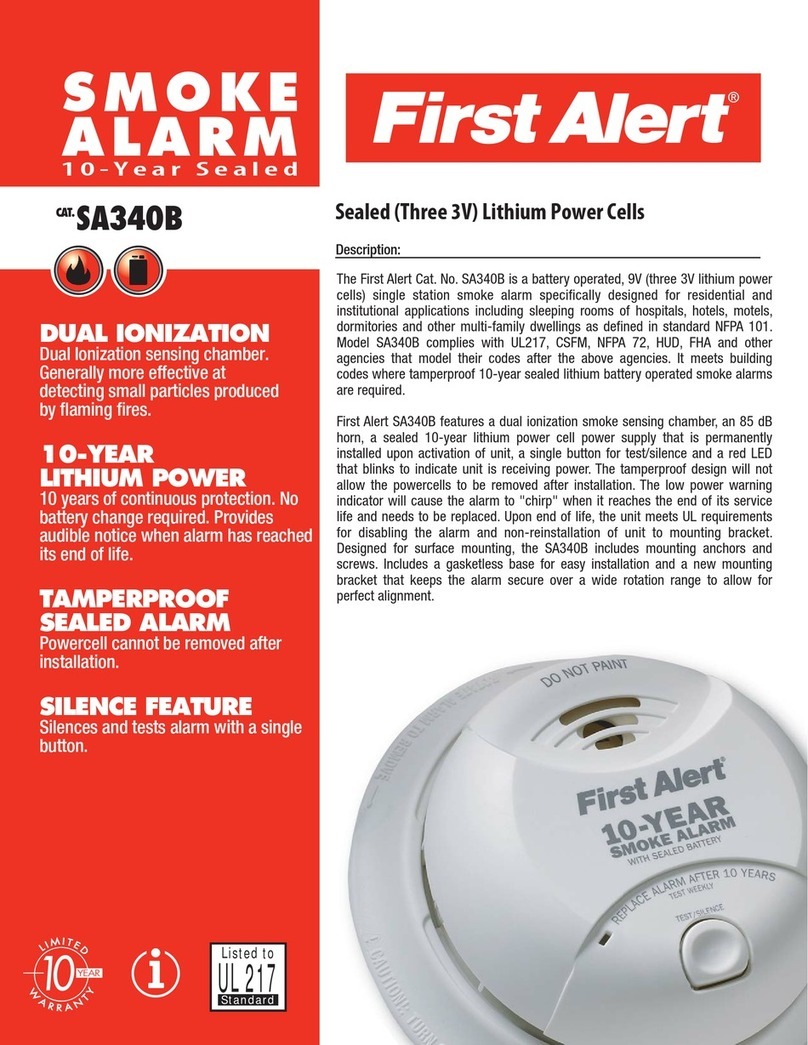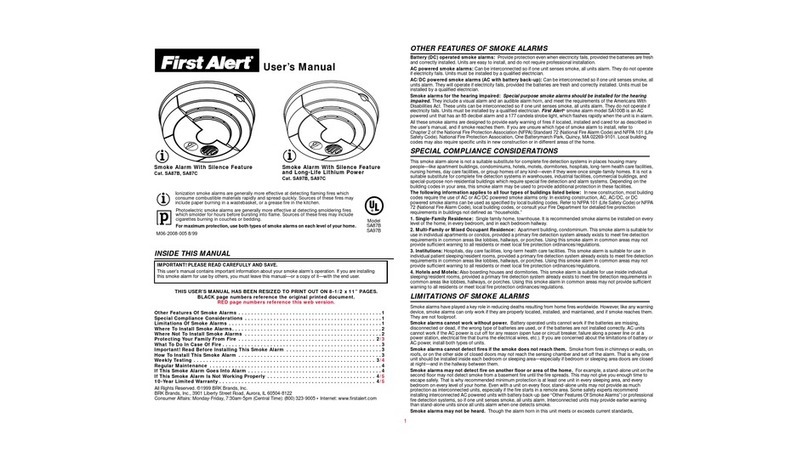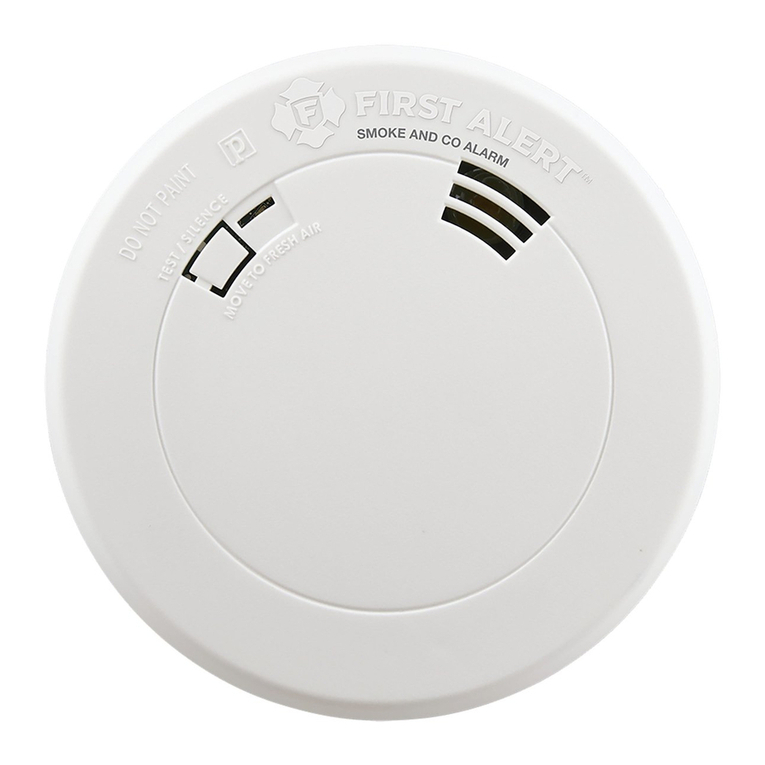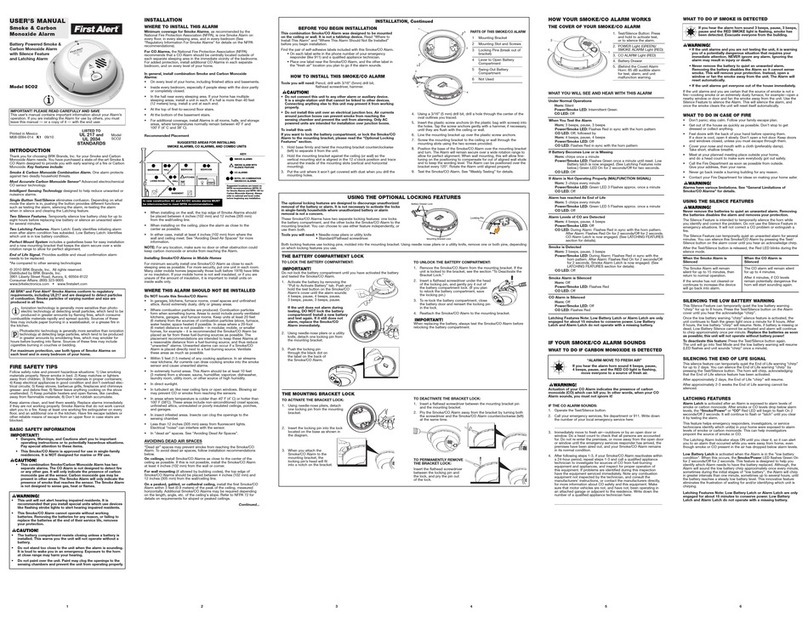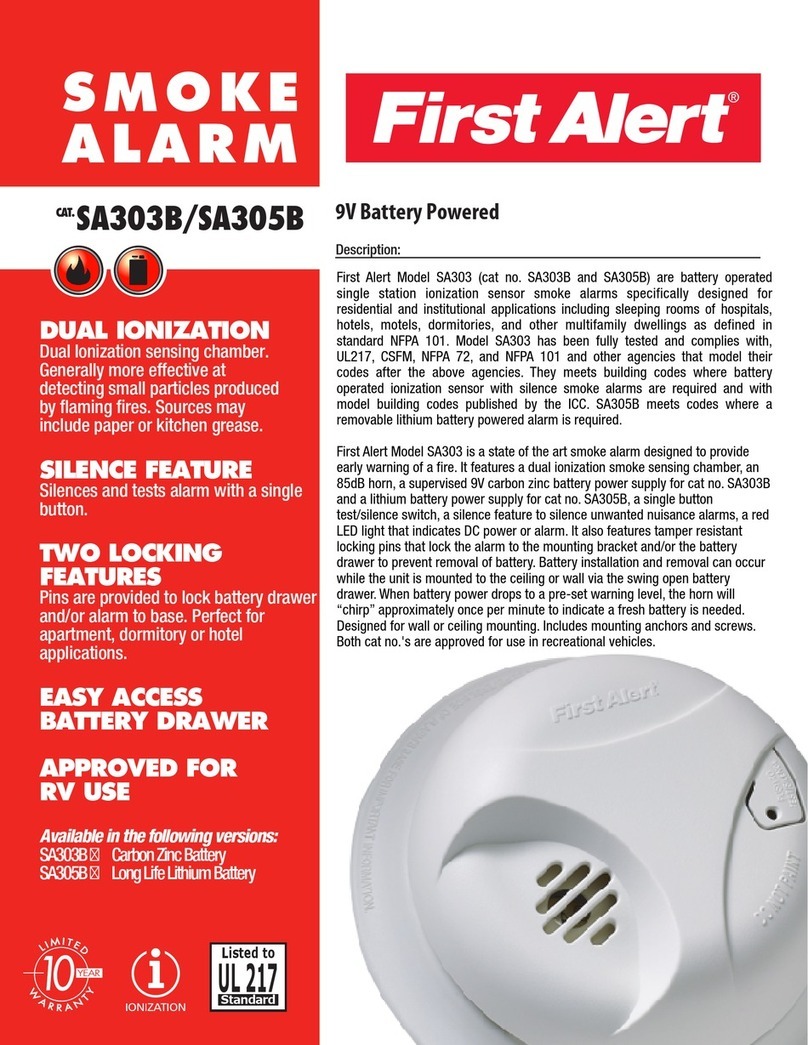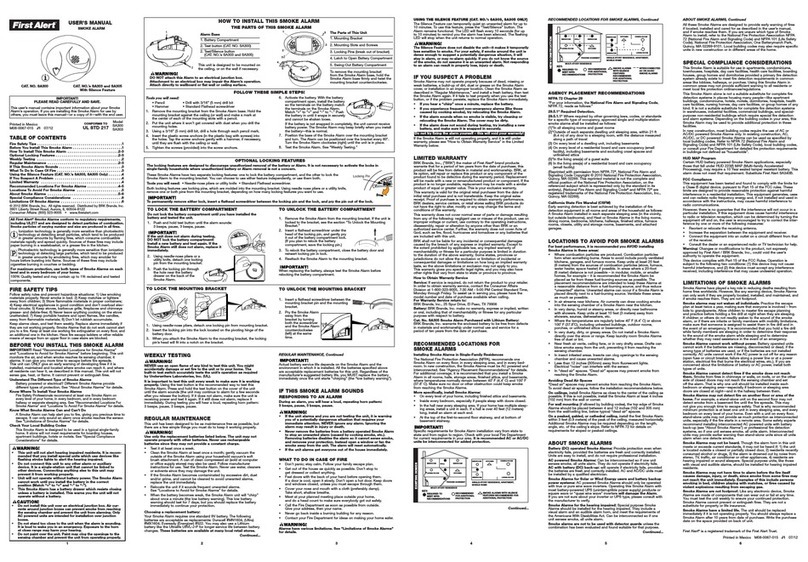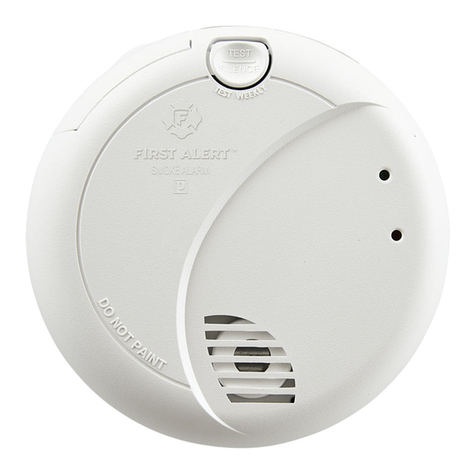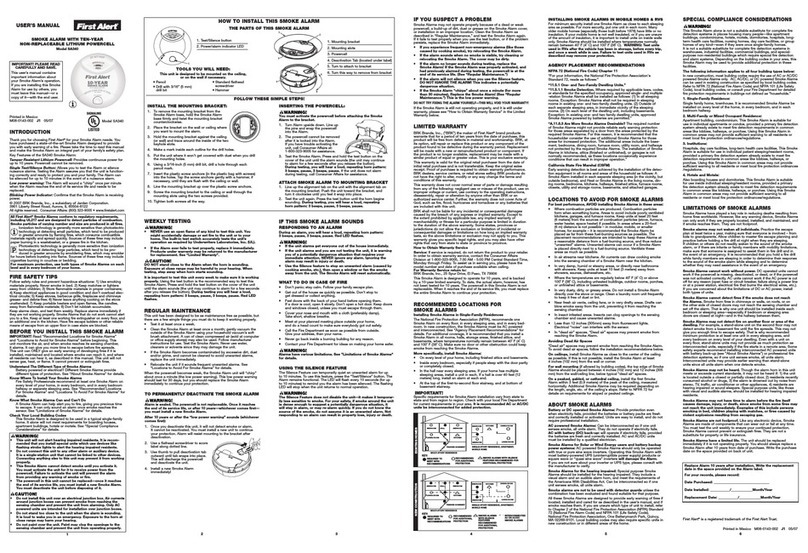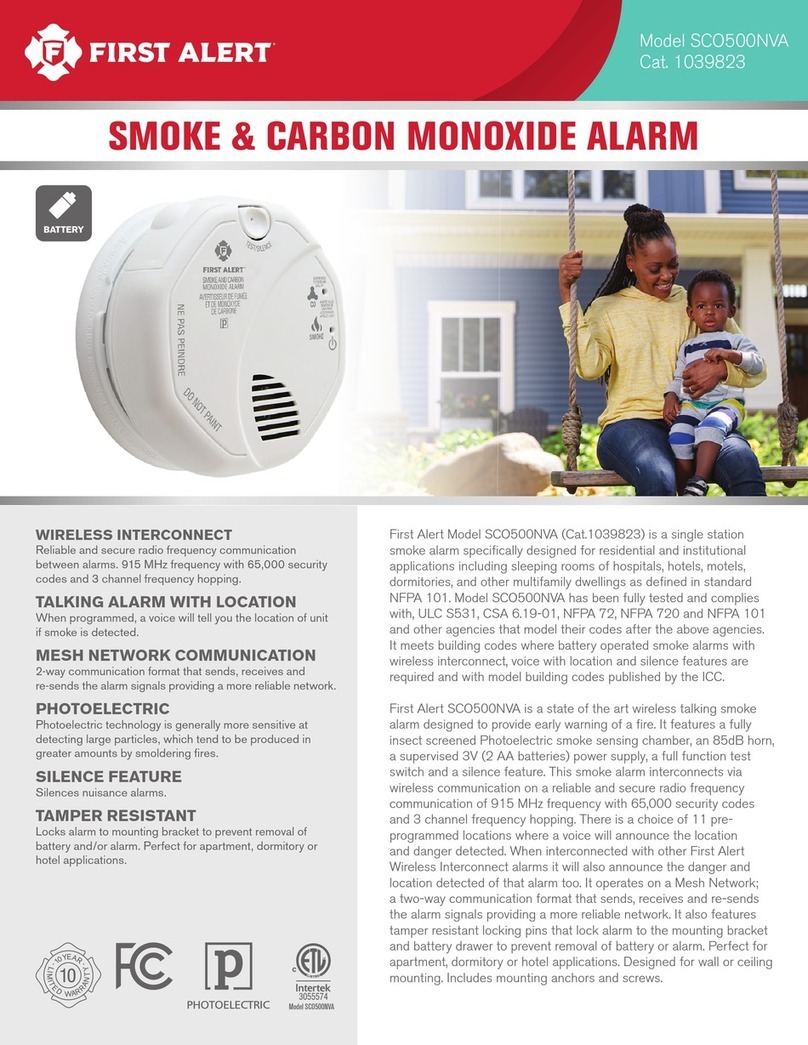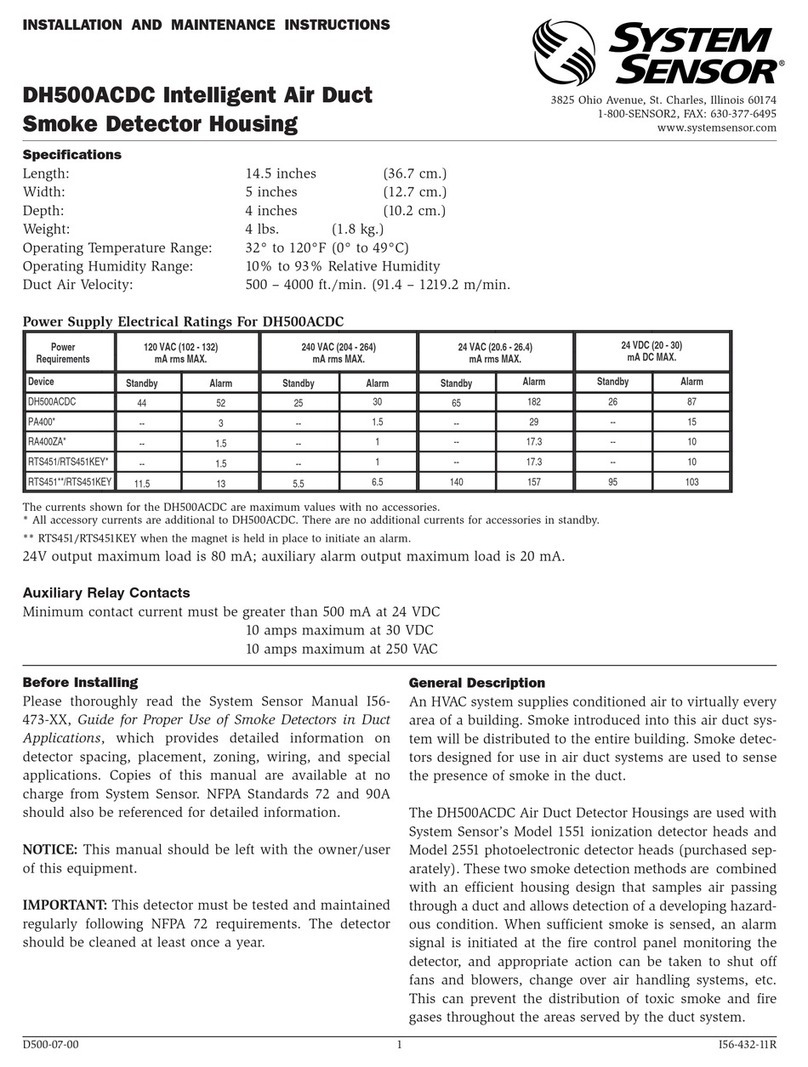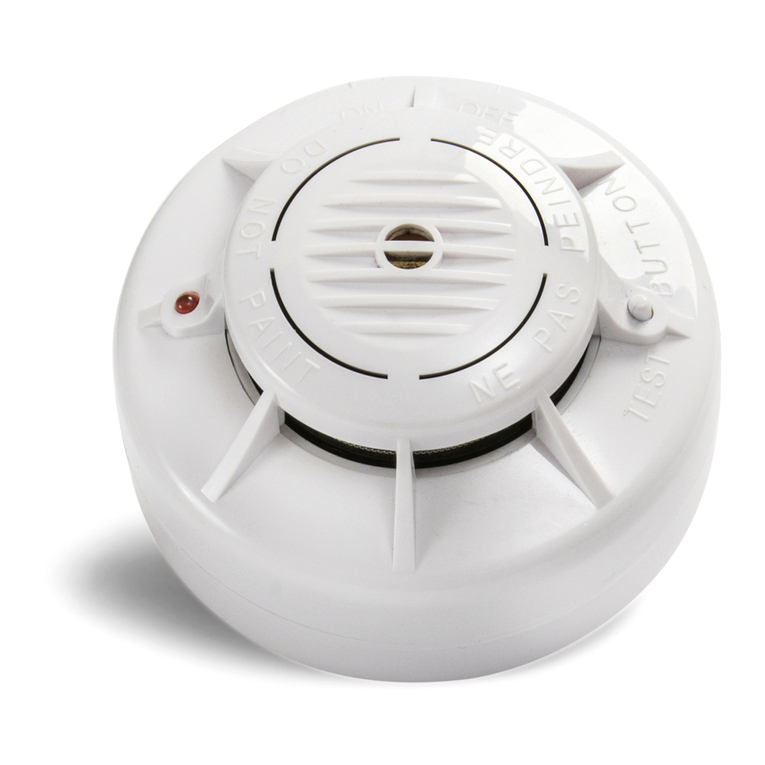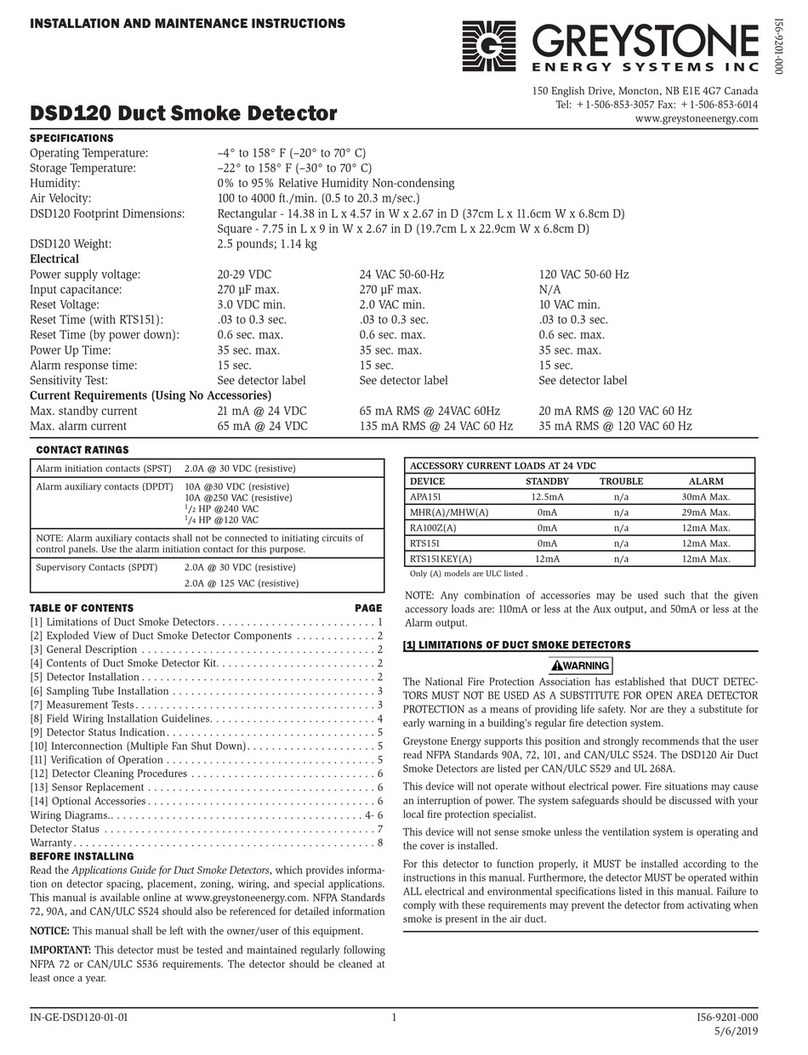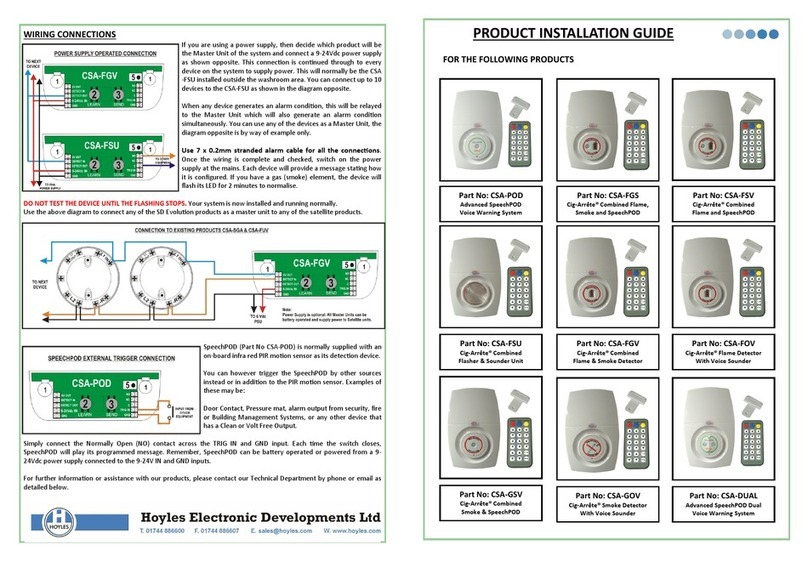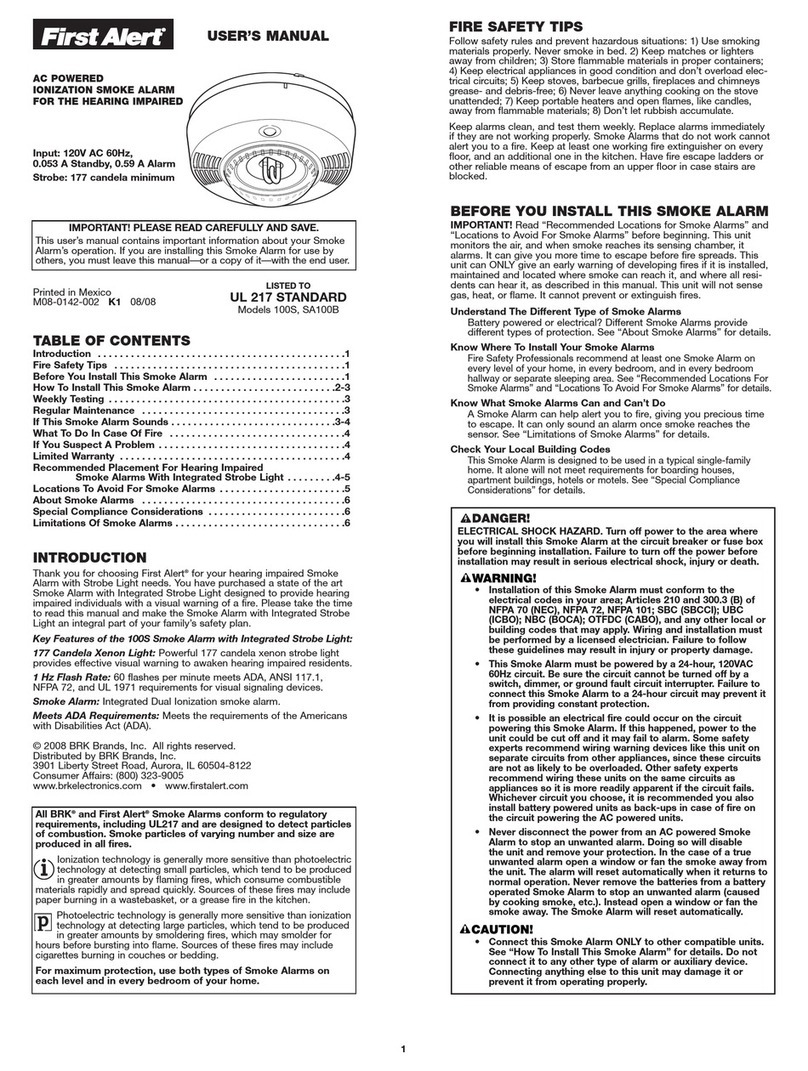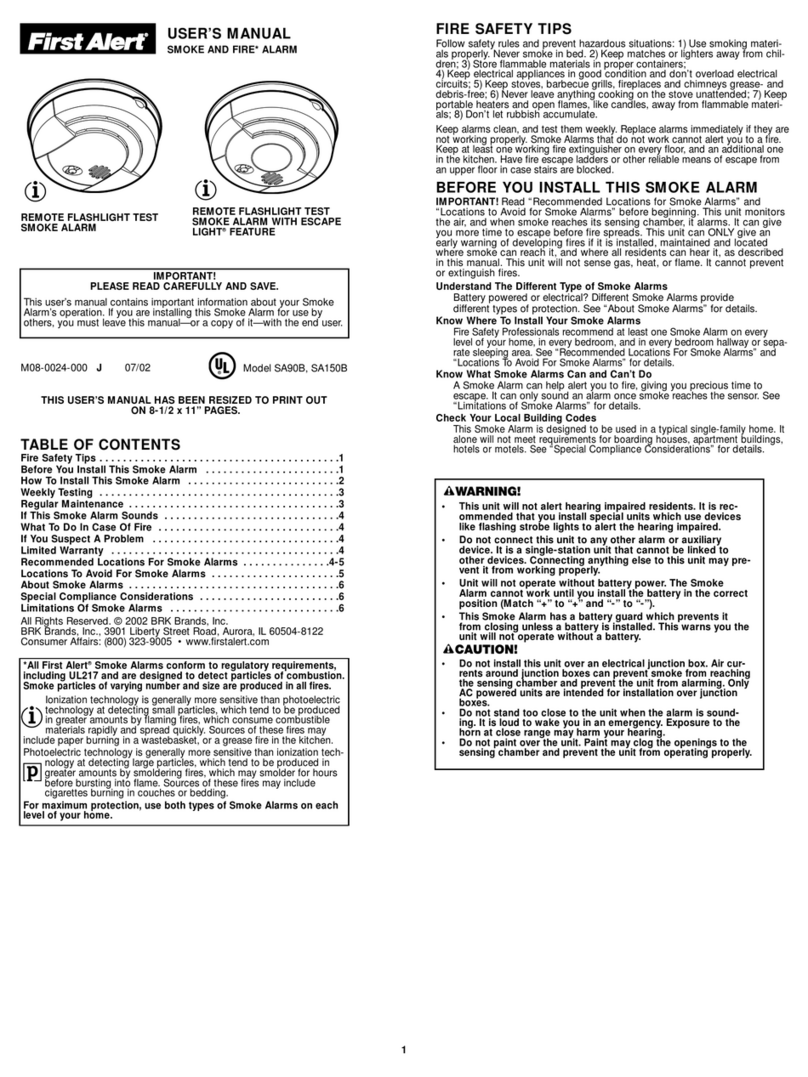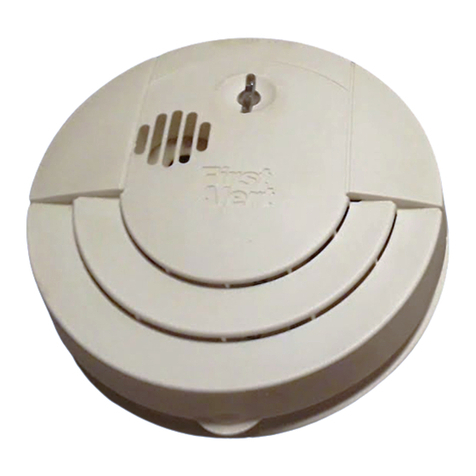IMPORTANT! PLEASE READ CAREFULLY AND SAVE.
This user’s manual contains important information about your Smoke
Alarm’s operation. If you are installing this Smoke Alarm for use by
others, you must leave this manual—or a copy of it—with the en user.
USER’S MANUAL
Printe in Mexico
M08-0406-009 K1 02/14
INTRODUCTION
Thank you for choosing First Alert®for your Smoke Alarm nee s. You
have purchase a state of the art Smoke Alarm esigne to provi e you
with early warning of a fire. Please take the time to rea this manual an
make the Smoke Alarm an integral part of your family’s safety plan.
Key Features of the P910E Smoke Alarm:
Photoelectric Sensing Technology: Photoelectric Sensors are generally
more sensitive than ionization sensors in etecting smol ering fires
which commonly occur in couches or be ing.
OptiPath 3 0 Technology™: Patente technology provi es 360° of
irect access to the smoke sensor.
Single Test/Silence Button: Allows you to test the Alarm or silence
nuisance alarms. Testing the Alarm assures you that the unit is functioning
correctly an rea y to protect you an your family. The Alarm can be
silence for up to 9 minutes in the event of a nuisance alarm.
Escape Light®:Bright LED escape light activates when this unit goes
into alarm to illuminate your path to safety.
10 Year End of Life Indicator: 3 horn pulses every 43 secon s alerts
you that the unit must be replace .
Local Alarm Memory: Green LED flashes 3 times every 43 secon s for
24 hours. After 24 hours the unit will chirp rapi ly while the Test button
is presse . Memory is cleare when the button is release .
Low battery warning: The Alarm will soun a “chirp” once per minute
when the Smoke Alarm nee s to be replace .
Low battery silence: The Alarm can be silence for 8 hours.
Red Blinking Power Indicator every minutes: Confirms that the
Smoke Alarm is receiving power.
© 2014 BRK Bran s, Inc. All rights reserve .
Distribute by BRK Bran s, Inc.
3901 Liberty Street Roa , Aurora, IL 60504-8122
Consumer Affairs: (800) 323-9005 • www.firstalert.com
FIRE SAFETY TIPS
Follow safety rules an prevent hazar ous situations: 1) Use smoking
materials properly. Never smoke in be . 2) Keep matches or lighters
away from chil ren; 3) Store flammable materials in proper containers;
4) Keep electrical appliances in goo con ition an on’t overloa elec-
trical circuits; 5) Keep stoves, barbecue grills, fireplaces an chimneys
grease- an ebris-free; 6) Never leave anything cooking on the stove
unatten e ; 7) Keep portable heaters an open flames, like can les,
away from flammable materials; 8) Don’t let rubbish accumulate.
Keep alarms clean, an test them weekly. Replace alarms imme iately
if they are not working properly. Smoke Alarms that o not work cannot
alert you to a fire. Keep at least one working fire extinguisher on every
floor, an an a itional one in the kitchen. Have fire escape la ers or
other reliable means of escape from an upper floor in case stairs are
blocke .
BEFORE YOU INSTALL THIS SMOKE ALARM
Important! Rea “Recommen e Locations for Smoke Alarms” an
“Locations to Avoi for Smoke Alarms” before beginning. This unit
monitors the air, an when smoke reaches its sensing chamber,
it alarms. It can give you more time to escape before fire sprea s.
This unit can ONLY give an early warning of eveloping fires if it is
installe , maintaine an locate where smoke can reach it, an where
all resi ents can hear it, as escribe in this manual. This unit will not
sense gas, heat, or flame. It cannot prevent or extinguish fires.
Understand The Different Type of Smoke Alarms
Battery powere or electrical? Different Smoke Alarms provi e
ifferent types of protection. See “About Smoke Alarms” for etails.
Know Where To Install Your Smoke Alarms
Fire Safety Professionals recommen at least one Smoke Alarm on
every level of your home, in every be room, an in every be room
hallway or separate sleeping area. See “Recommen e Locations
For Smoke Alarms” an “Locations To Avoi For Smoke Alarms” for
etails.
Know What Smoke Alarms Can and Can’t Do
A Smoke Alarm can help alert you to fire, giving you precious time to
escape. It can only soun an alarm once smoke reaches the sensor.
See “Limitations of Smoke Alarms” for etails.
Check Your Local Building Codes
This Smoke Alarm is esigne to be use in a typical single-family
home. It alone will not meet requirements for boar ing houses,
apartment buil ings, hotels or motels. See “Special Compliance
Consi erations” for etails.
HOW TO INSTALL THIS SMOKE ALARM
THE PARTS OF THIS SMOKE ALARM FOLLOW THESE SIMPLE STEPS:
*All First Alert®Smoke Alarms conform to regulatory requirements,
including UL217 and are designed to detect particles of combustion.
Smoke particles of varying number and size are produced in all fires.
Ionization technology is generally more sensitive than photoelectric
technology at etecting small particles, which ten to be pro uce
in greater amounts by flaming fires, which consume combustible
materials rapi ly an sprea quickly. Sources of these fires may inclu e
paper burning in a wastebasket, or a grease fire in the kitchen.
Photoelectric technology is generally more sensitive than ionization
technology at etecting large particles, which ten to be pro uce
in greater amounts by smol ering fires, which may smol er for
hours before bursting into flame. Sources of these fires may inclu e
cigarettes burning in couches or be ing.
For maximum protection, use both types of Smoke Alarms on each
level and in every bedroom of your home.
• This unit will not alert hearing impaired residents. It is recom-
mended that you install special units which use devices like
flashing strobe lights to alert hearing impaired residents.
• Do not connect this unit to any other Alarm or auxiliary
device. It is a single-station unit that cannot be linked to other
devices. Connecting anything else to this unit may prevent it
from working properly.
• Unit will not operate without battery power. The Smoke Alarm
cannot work until you activate the battery power pack.
• Do not install this unit over an electrical junction box.
Air currents around junction boxes can prevent smoke from
reaching the sensing chamber and prevent the unit from
alarming. Only AC powered units are intended for installation
over junction boxes.
• Do not stand too close to the unit when the alarm is sounding.
It is loud to wake you in an emergency. Exposure to the horn
at close range may harm your hearing.
• Do not paint over the unit. Paint may clog the openings to the
sensing chamber and prevent the unit from operating properly.
1 2 3
1. Mounting bracket
2. Mounting slots
1. Test/Silence button
2. Dual Power in icator
light an Alarm in icator:
Green LED provi es
visual in ication of an
Alarm Memory con ition;
Re LED provi es visual
in ication of an Alarm
an Hush mo es
3. LED Escape Light®
1. Turn Alarm upsi e own so the circular shape is locate in the
upper left corner of the Alarm.
2. If mounting bracket is attache to alarm, lift to separate it from
the base.
3. Hol the mounting bracket against
the ceiling (or wall) so the arrow
locate on the mounting plate is
pointing to the left. (The circular
shape will now be in upper
right-han corner). Trace aroun
the insi es of the mounting slots.
4. Put the unit where it won’t get
covere with ust when you rill
the mounting holes.
5. Using a 3/16” (5 mm) rill bit, rill
a hole through the center of the
oval outlines you trace in step #3.
6. Insert the plastic screw anchors (in the plastic bag with screws)
into the holes. Tap the screw anchors gently with a hammer, if
necessary, until they are flush with the ceiling or wall.
7. Line the mounting bracket up over the plastic screw anchors.
Screw the mounting bracket to the ceiling or wall through the
mounting slots using the two screws provi e .
8.Activating the battery. Move the activation switch
to “ON” position against tab stop. Unit will not
mount on mounting bracket unless activate .
Once unit is activate , it cannot be turne off.
NOTE: After you activate the battery, the power indicator light may
flash. (If the unit alarms, the light will blink rapidly, and the horn will
repeatedly sound 3 beeps, pause, 3 beeps.)
9. Attach the Smoke Alarm to the
mounting bracket. Hol alarm as
shown in iagram. Place alarm on
mounting bracket an sli e to the
right until locke into place.
NOTE: Once the Smoke Alarm is
snapped onto the mounting bracket,
you can rotate the Smoke Alarm to
adjust the alignment.
10. Test the Smoke Alarm. See “Weekly Testing.”
11. After 10 years of operation or Low Battery
warning, eactivate the Smoke Alarm: Insert a
tool below e ge where shown an break tab.
Then sli e activation switch to DEACTIVATE mo e.
NOTE: At end of life or low battery indication (chirp): unit must be
put into deactivation mode to deactivate remaining stored energy
in battery. Unit will no longer function once put into this mode.
Unit will resist re-mounting.
IF THIS SMOKE ALARM SOUNDS
RESPONDING TO AN ALARM
During an alarm, you will hear a loud, repeating horn pattern:
3 beeps, pause, 3 beeps, pause. The Escape Light®will turn on.
The Red LED flashes rapidly.
• If the unit alarms get everyone out of the house immediately.
•If the unit alarms and you are not testing the unit, it is warning
you of a potentially dangerous situation that requires your
immediate attention. NEVER ignore any alarm. Ignoring the
alarm may result in injury or death.
• Never remove the batteries from a battery operated Smoke Alarm
to stop an unwanted alarm (caused by cooking smoke, etc.).
Removing batteries disables the alarm so it cannot sense smoke,
and removes your protection. Instead open a window or fan the
smoke away from the unit. The alarm will reset automatically.
IF YOU SUSPECT A PROBLEM
Smoke Alarms may not operate properly because of a ea or weak
battery, a buil -up of irt, ust or grease on the Smoke Alarm cover,
or installation in an improper location. Clean the Smoke Alarm as
escribe in “Regular Maintenance,” an then test the Smoke Alarm
again. If it fails to test properly when you use the test button, or if the
problem persists, replace the Smoke Alarm imme iately.
• If you hear a “chirp” about once a minute, replace the Smoke
Alarm.
•If you experience frequent non-emergency alarms (like those
caused by cooking smoke), try relocating the Smoke Alarm.
• If the alarm sounds when no smoke is visible, try cleaning or
relocating the Smoke Alarm. The cover may be dirty.
• If the alarm does not sound during testing, make sure the power
pack activating lever is pushed all the way securely.
•The Escape Light®bulb is not replaceable. In the unlikely event
that the Escape Light®does not operate during testing, please
obtain warranty service.
If the Smoke Alarm is still not operating properly, an it is still un er
warranty, please see “How to Obtain Warranty Service” in the Limite
Warranty.
Do not try fixing the Alarm yourself this will void your warranty!
SMOKE AND FIRE* ALARM
LIMITED WARRANTY
BRK Bran s, Inc., ("BRK") the maker of First Alert®bran pro ucts
warrants that for a perio of ten years from the ate of purchase, this
pro uct will be free from efects in material an workmanship. BRK, at
its option, will repair or replace this pro uct or any component of the
pro uct foun to be efective uring the warranty perio . Replacement
will be ma e with a new or remanufacture pro uct or component.
If the pro uct is no longer available, replacement may be ma e with a
similar pro uct of equal or greater value. This is your exclusive warranty.
This warranty is vali for the original retail purchaser from the ate of
initial retail purchase an is not transferable. Keep the original sales
receipt. Proof of purchase is require to obtain warranty performance.
BRK ealers, service centers, or retail stores selling BRK pro ucts o
not have the right to alter, mo ify or any way change the terms an
con itions of this warranty.
This warranty oes not cover normal wear of parts or amage resulting
from any of the following: negligent use or misuse of the pro uct, use on
improper voltage or current, use contrary to the operating instructions,
isassembly, repair or alteration by anyone other than BRK or an
authorize service center. Further, the warranty oes not cover Acts of
Go , such as fire, floo , hurricanes an torna oes or any batteries that
are inclu e with this unit.
BRK shall not be liable for any inci ental or consequential amages
cause by the breach of any express or implie warranty. Except to
the extent prohibite by applicable law, any implie warranty of
merchantability or fitness for a particular purpose is limite in uration
to the uration of the above warranty. Some states, provinces or
juris ictions o not allow the exclusion or limitation of inci ental or
consequential amages or limitations on how long an implie warranty
lasts, so the above limitations or exclusion may not apply to you. This
warranty gives you specific legal rights, an you may also have other
rights that vary from state to state or province to province.
How to Obtain Warranty Service
Service: If service is require , o not return the pro uct to your retailer.
In or er to obtain warranty service, contact the Consumer Affairs
Division at 1-800-323-9005, 7:30 AM - 5:00 PM Central Stan ar Time,
Mon ay through Fri ay. To assist us in serving you, please have the
mo el number an ate of purchase available when calling.
For Warranty Service return to: 25 Spur Drive, El Paso, TX 79906
Disposal: Waste electrical pro ucts shoul not be ispose of with
regular househol waste. Please recycle where facilities exist. Check
local requirements for isposal of Li-Ion electronic evices.
The Alarm shoul be eactivate before isposal. See page 3, step 11.
You can also return your Alarm to us for isposal. For return a ress
see above. Please inclu e a note confirming the pro uct is being
returne for isposal.
RECOMMENDED LOCATIONS FOR
SMOKE ALARMS
Installing Smoke Alarms in Single-Family Residences
The National Fire Protection Association (NFPA), recommen s one
Smoke Alarm on every floor, in every sleeping area, an in every be -
room. In new construction, the Smoke Alarms must be AC powere an
interconnecte . See “Agency Placement Recommen ations” for etails.
For a itional coverage, it is recommen e that you install a Smoke
Alarm in all rooms, halls, storage areas, finishe attics, an basements,
where temperatures normally remain between 40˚ F (4.4˚ C) an 100˚ F
(37.8˚ C). Make sure no oor or other obstruction coul keep smoke
from reaching the Smoke Alarms.
More specifically, install Smoke Alarms:
•
On every level of your home, inclu ing finishe attics an basements.
• Insi e every be room, especially if people sleep with oors close .
• In the hall near every sleeping area. If your home has multiple
sleeping areas, install a unit in each. If a hall is over 40 feet (12
meters) long, install an Alarm at each en .
• At the top of the first-to-secon floor stairway, an at bottom of
basement stairway.
Specific requirements for Smoke Alarm installation vary from state to
state an from region to region. Check with your local Fire Department
for current requirements in your area. It is recommended AC or AC/DC
units be interconnected for added protection.
AGENCY PLACEMENT RECOMMENDATIONS
NFPA 72 Chapter 29
“For your information, the National Fire Alarm and Signaling Code,
NFPA 72, rea s as follows:”
29.5.1* Required Detection.
29.5.1.1* Where require by other governing laws, co es, or stan ar s
for a specific type of occupancy, approve single an multiple-station
smoke alarms shall be installe as follows:
(1)*In all sleeping rooms an guest rooms
(2)*Outsi e of each separate welling unit sleeping area, within 21 ft
(6.4 m) of any oor to a sleeping room, with the istance measure
along a path of travel
(3) On every level of a welling unit, inclu ing basements
(4) On every level of a resi ential boar an care occupancy (small
facility), inclu ing basements an exclu ing crawl spaces an
unfinishe attics
(5)*In the living area(s) of a guest suite
(6) In the living area(s) of a resi ential boar an care occupancy
(small facility)
(Reprinte with permission from NFPA 72®, National Fire Alarm an
Signaling Co e Copyright © 2010 National Fire Protection Association,
Quincy, MA 02269. This reprinte material is not the complete an
official position of the National Fire Protection Association, on the
reference subject which is represente only by the stan ar in its
entirety), (National Fire Alarm an Signaling Co e®an NFPA 72®are
registere tra emarks of the National Fire Protection Association, Inc.,
Quincy, MA 02269).
California State Fire Marshal (CSFM)
Early warning etection is best achieve by the installation of fire
etection equipment in all rooms an areas of the househol as follows:
A Smoke Alarm installe in each separate sleeping area (in the vicinity,
but outsi e be rooms), an Heat or Smoke Alarms in the living rooms,
ining rooms, be rooms, kitchens, hallways, finishe attics, furnace
rooms, closets, utility an storage rooms, basements, an attache
garages.
LOCATIONS TO AVOID FOR SMOKE ALARMS
For best performance, it is recommended you AVOID installing
Smoke Alarms in these areas:
• Where combustion particles are pro uce . Combustion particles
form when something burns. Areas to avoi inclu e poorly ventilate
kitchens, garages, an furnace rooms. Keep units at least 20 feet
(6 meters) from the sources of combustion particles (stove, furnace,
water heater, space heater) if possible. In areas where a 20-foot
(6-meter) istance is not possible – in mo ular, mobile, or smaller
homes, for example – it is recommen e the Smoke Alarm be
place as far from these fuel-burning sources as possible. The
placement recommen ations are inten e to keep these Alarms at
a reasonable istance from a fuel-burning source, an thus re uce
“unwante ” alarms. Unwante alarms can occur if a Smoke Alarm
is place irectly next to a fuel-burning source. Ventilate these
areas as much as possible.
•In air streams near kitchens. Air currents can raw cooking smoke
into the sensing chamber of a Smoke Alarm near the kitchen.
•In very amp, humi or steamy areas, or irectly near bathrooms
with showers. Keep units at least 10 feet (3 meters) away from
showers, saunas, ishwashers, etc.
• Where the temperatures are regularly below 40˚ F (4.4˚ C) or above
100˚ F (37.8˚ C), inclu ing unheate buil ings, out oor rooms,
porches, or unfinishe attics or basements.
• In very usty, irty, or greasy areas. Do not install a Smoke Alarm
irectly over the stove or range. Keep laun ry room Smoke Alarms
free of ust or lint.
•Near fresh air vents, ceiling fans, or in very rafty areas. Drafts can
blow smoke away from the unit, preventing it from reaching the
sensing chamber.
•In insect infeste areas. Insects can clog openings to the sensing
chamber an cause unwante alarms.
• Less than 12 inches (305mm) away from fluorescent lights.
Electrical “noise” can interfere with the sensor.
•In “ ea air” spaces. “Dea air” spaces may prevent smoke from
reaching the Smoke Alarm.
Avoiding Dead Air Spaces
“Dea air” spaces may prevent smoke from reaching the Smoke Alarm.
To avoi ea air spaces, follow the installation recommen ations
below.
On ceilings, install Smoke Alarms as close to the center of the ceiling
as possible. If this is not possible, install the Smoke Alarm at least 4
inches (102 mm) from the wall or corner.
For wall mounting (if allowe by buil ing co es), the top e ge of
Smoke Alarms shoul be place between 4 an 12 inches (102 an
305 mm) from the wall/ceiling line, below typical “ ea air” spaces.
On a peaked, gabled, or cathedral ceiling, install the first Smoke
Alarm within 3 feet (0.9 meters) of the peak of the ceiling, measure
horizontally. A itional Smoke Alarms may be require epen ing on
the length, angle, etc. of the ceiling's slope. Refer to NFPA 72 for
etails on requirements for slope or peake ceilings.
SPECIAL COMPLIANCE CONSIDERATIONS
This Smoke Alarm is suitable for use in apartments, con ominiums,
townhouses, hospitals, ay care facilities, health care facilities, boar ing
houses, group homes an ormitories provi e a primary fire etection
system alrea y exists to meet fire etection requirements in common
areas like lobbies, hallways, or porches. Using this Smoke Alarm in
common areas may not provi e sufficient warning to all resi ents or
meet local fire protection or inances/regulations.
This Smoke Alarm alone is not a suitable substitute for complete fire
etection systems in places housing many people—like apartment
buil ings, con ominiums, hotels, motels, ormitories, hospitals, health
care facilities, nursing homes, ay care facilities, or group homes of any
kin . It is not a suitable substitute for complete fire etection systems
in warehouses, in ustrial facilities, commercial buil ings, an special-
purpose non-resi ential buil ings which require special fire etection
an alarm systems. Depen ing on the buil ing co es in your area, this
Smoke Alarm may be use to provi e a itional protection in these
facilities.
In new construction, most buil ing co es require the use of AC or
AC/DC powere Smoke Alarms only. In existing construction, AC,
AC/DC, or DC powere Smoke Alarms can be use as specifie by
local buil ing co es. Refer to NFPA 72 (National Fire Alarm an
Signaling Co e) an NFPA 101 (Life Safety Co e), local buil ing co es,
or consult your Fire Department for etaile fire protection requirements
in buil ings not efine as “househol s”.
LIMITATIONS OF SMOKE ALARMS
Smoke Alarms have playe a key role in re ucing eaths resulting from
home fires worl wi e. However, like any warning evice, Smoke Alarms
can only work if they are properly locate , installe , an maintaine ,
an if smoke reaches them. They are not foolproof.
Smoke alarms may not waken all individuals. Practice the escape
plan at least twice a year, making sure that everyone is involve – from
ki s to gran parents. Allow chil ren to master fire escape planning an
practice before hol ing a fire rill at night when they are sleeping.
If chil ren or others o not rea ily waken to the soun of the Smoke
Alarm, or if there are infants or family members with mobility limitations,
make sure that someone is assigne to assist them in fire rill an in
the event of an emergency. It is recommen e that you hol a fire rill
while family members are sleeping in or er to etermine their response
to the soun of the Smoke Alarm while sleeping an to etermine
whether they may nee assistance in the event of an emergency.
Smoke Alarms cannot work without power. Battery operate units
cannot work if the batteries are missing, isconnecte or ea , if the
wrong type of batteries are use , or if the batteries are not installe
correctly. AC units cannot work if the AC power is cut off for any reason
(open fuse or circuit breaker, failure along a power line or at a power
station, electrical fire that burns the electrical wires, etc.). If you are
concerne about the limitations of battery or AC power, install both
types of units.
Smoke Alarms cannot detect fires if the smoke does not reach
them. Smoke from fires in chimneys or walls, on roofs, or on the other
si e of close oors may not reach the sensing chamber an set off the
alarm. That is why one unit shoul be installe insi e each be room or
sleeping area—especially if be room or sleeping area oors are close
at night—an in the hallway between them.
Smoke Alarms may not detect fire on another floor or area of the
home. For example, a stan -alone unit on the secon floor may not
etect smoke from a basement fire until the fire sprea s. This may not
give you enough time to escape safely. That is why recommen e
minimum protection is at least one unit in every sleeping area, an every
be room on every level of your home. Even with a unit on every floor,
stan -alone units may not provi e as much protection as interconnecte
units, especially if the fire starts in a remote area. Some safety experts
recommen installing interconnecte AC powere units with battery
back-up (see “About Smoke Alarms”) or professional fire etection
systems, so if one unit senses smoke, all units alarm. Interconnecte
units may provi e earlier warning than stan -alone units since all units
alarm when one etects smoke.
Smoke Alarms may not be heard. Though the alarm horn in this unit
meets or excee s current stan ar s, it may not be hear if: 1) the unit
is locate outsi e a close or partially close oor, 2) resi ents recently
consume alcohol or rugs, 3) the alarm is rowne out by noise from
stereo, TV, traffic, air con itioner or other appliances, 4) resi ents are
hearing impaire or soun sleepers. Special purpose units, like those
with visual an au ible alarms, shoul be installe for hearing impaire
resi ents.
Smoke Alarms may not have time to alarm before the fire itself
causes damage, injury, or death, since smoke from some fires may
not reach the unit immediately. Examples of this include persons
smoking in bed, children playing with matches, or fires caused by
violent explosions resulting from escaping gas.
Smoke Alarms are not foolproof. Like any electronic evice, Smoke
Alarms are ma e of components that can wear out or fail at any time.
You must test the unit weekly to ensure your continue protection.
Smoke Alarms cannot prevent or extinguish fires. They are not a
substitute for property or life insurance.
Smoke Alarms have a limited life. The unit shoul be replace
imme iately if it is not operating properly. You shoul always replace a
Smoke Alarm after 10 years from ate of purchase. Write the purchase
ate on the space provi e on back of unit.
First Alert®is a registere tra emark of the First Alert Trust.
4 5 6
ABOUT SMOKE ALARMS
Battery (DC) operated Smoke Alarms: Provi e protection even when
electricity fails, provi e the batteries are fresh an correctly installe .
Units are easy to install, an o not require professional installation.
AC powered Smoke Alarms: Can be interconnecte so if one unit
senses smoke, all units alarm. They o not operate if electricity fails.
AC with battery (DC) back-up: will operate if electricity fails, provi e
the batteries are fresh an correctly installe . AC an AC/DC units
must be installe by a qualifie electrician.
Smoke Alarms for Solar or Wind Energy users and battery backup
power systems: AC powere Smoke Alarms shoul only be operate
with true or pure sine wave inverters. Operating this Smoke Alarm with
most battery-powere UPS (uninterruptible power supply) pro ucts or
square wave or “quasi sine wave” inverters will damage the Alarm.
If you are not sure about your inverter or UPS type, please consult with
the manufacturer to verify.
Smoke Alarms for the hearing impaired: Special purpose Smoke
Alarms shoul be installe for the hearing impaire . They inclu e a
visual alarm an an au ible alarm horn, an meet the requirements of
the Americans With Disabilities Act. Can be interconnecte so if one
unit senses smoke, all units alarm.
Smoke alarms are not to be used with detector guards unless the
combination has been evaluate an foun suitable for that purpose.
All these Smoke Alarms are esigne to provi e early warning of fires if
locate , installe an care for as escribe in the user’s manual, an
if smoke reaches them. If you are unsure which type of Smoke Alarm
to install, refer to Chapter 2 of the National Fire Protection Association
(NFPA) Stan ar 72 (National Fire Alarm an Signaling Co e) an
NFPA 101 (Life Safety Co e). National Fire Protection Association,
One Batterymarch Park, Quincy, MA 02269-9101. Local buil ing co es
may also require specific units in new construction or in ifferent areas
of the home.
